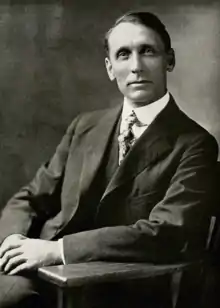Edward Morgan Lewis | |
|---|---|
 Edward M. Lewis circa 1922 | |
| President of the Massachusetts Agricultural College (now the University of Massachusetts Amherst) | |
| In office 1924–1927 | |
| 5th President of the University of New Hampshire | |
| In office 1927–1936 | |
| Preceded by | Ralph D. Hetzel |
| Succeeded by | Fred Engelhardt |
| Personal details | |
| Born | 25 December 1872 Machynlleth, Wales |
| Died | 23 March 1936 (aged 63) Durham, New Hampshire, U.S. |
| Political party | Democratic |
| Spouse | Margaret H. Williams (1896–1936) |
| Alma mater | Williams College (A.B., A.M.) Boston School of Expression |
| Signature | |
| Ted Lewis | |
|---|---|
 | |
| Pitcher | |
| Born: 25 December 1872 Machynlleth, Wales | |
| Died: 23 March 1936 (aged 63) Durham, New Hampshire | |
Batted: Right Threw: Right | |
| MLB debut | |
| 6 July, 1896, for the Boston Beaneaters | |
| Last MLB appearance | |
| 26 September, 1901, for the Boston Americans | |
| MLB statistics | |
| Win–loss record | 94–64 |
| Strikeouts | 378 |
| Earned run average | 3.53 |
| Teams | |
| |
| Career highlights and awards | |
| |
Edward Morgan Lewis (25 December 1872 – 23 May 1936), otherwise known as Ted Lewis, was a Welsh born, American Major League Baseball right-handed pitcher as well as a professor of English literature, academic administrator, the tenth president of the Massachusetts Agricultural College and fifth President of the University of New Hampshire.
Biography
Early life
Lewis was born in 1872 in Machynlleth, Wales. He came to the United States in 1880.[1]
Baseball career
Nicknamed "The Pitching Professor" and "Parson", Lewis was an ordained minister who earned a master's degree from Williams College. He was one of three Welsh-born players to break into major league baseball in the U.S. He was 23 years old when he debuted with the Boston Beaneaters on 6 July 1896.
Lewis pitched a full season in 1897 and earned 21 wins. He was one of three Boston pitchers to finish the season with more than 20 wins. Boston won the league pennant that season and repeated as champions in 1898.[2] His 26–8 win–loss record in 1898 amounted to a league-high winning percentage (.765).[3]
Lewis earned a 17–11 record in 1899, followed by a 13–12 record in 1900. He finished the 1901 season with a 16–17 record and a 3.53 earned run average (ERA). Lewis finished his career with a 94–64 record and a 3.53 ERA.[3]
Academic career
After the 1901 season, Lewis retired from baseball to teach full-time at Columbia University. He was instructor of Elocution at Columbia until 1904, when he returned to Williams College as a public speaking instructor and was later made an assistant professor.[1]
Lewis later left for Massachusetts Agricultural College (MAC), where he served as an English professor, department head and dean.[1] He was the president of MAC between 1924 and 1927, and when his liberal philosophy created disagreements with the college's trustees, he submitted his resignation.[4]
Lewis became president of the University of New Hampshire (UNH) in 1927. The university credits him with continuing the development of the school despite the difficulties associated with the Great Depression. He oversaw the construction of new buildings and athletic fields during his tenure.[1] A recreational area known as Lewis Fields constructed from December 1933 to September 1936 was named in his honor.[5] This area includes UNH's college football stadium—now known as Wildcat Stadium—which was known as Lewis Stadium or Lewis Field until it was formally named Cowell Stadium in 1952 in honor of former head coach Butch Cowell.[6][7]
Lewis remained at UNH until his death in 1936.[1] He is buried in Durham Cemetery in Durham, New Hampshire.[3] Lewis was friends with poet Robert Frost, who contributed a reading at Lewis's memorial service.[1]
References
- 1 2 3 4 5 6 "Guide to the Edward Morgan Lewis Papers, 1927–1936". University of New Hampshire. 25 June 2014. Retrieved 21 March 2015.
- ↑ Soos, Troy (11 December 2006). Before the Curse: The Glory Days of New England Baseball, 1858–1918, rev. ed. McFarland. p. 102. ISBN 978-0-7864-2625-6. Retrieved 21 March 2015.
- 1 2 3 "Ted Lewis Statistics and History". Baseball-Reference.com. Retrieved 21 March 2015.
- ↑ "Former chancellors". University of Massachusetts Amherst. Retrieved 21 March 2015.
- ↑ "Guide to the History of Lewis Fields, 1936". University of New Hampshire. 25 June 2014. Retrieved 21 March 2015.
- ↑ "Lewis Field to be Dedicated on 10 Oct". The Portsmouth Herald. Portsmouth, New Hampshire. 3 October 1936. p. 2. Retrieved 29 November 2019 – via newspapers.com.
- ↑ "UNH Football Field Is Cowell Stadium". The Burlington Free Press. Burlington, Vermont. Associated Press. 19 June 1952. p. 21. Retrieved 29 November 2019 – via newspapers.com.
External links
- University of New Hampshire: Office of the President
- Full list of University Presidents (including interim Presidents) , University of New Hampshire Library
- "Guide to the Edward M. Lewis Papers, 1927-1936", University of New Hampshire Library
- Career statistics and player information from Baseball Reference, or Baseball Reference (Minors)
- Ffaith
- Baseball Almanac
- Ted Lewis at Find a Grave